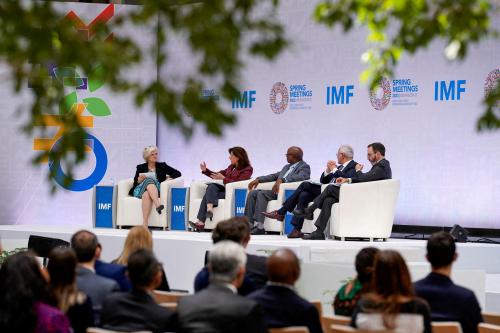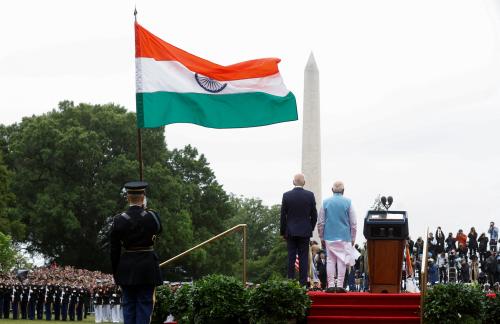Content from the Brookings Institution India Center is now archived. After seven years of an impactful partnership, as of September 11, 2020, Brookings India is now the Centre for Social and Economic Progress, an independent public policy institution based in India.
The connectivity initiatives that China and other Asian countries are pursuing across Asia and the Indian Ocean region—building new infrastructure, institutions, and interlinkages—is arguably redrawing the continent’s map. That has not just economic implications, but geopolitical ones. India has been relatively silent on perhaps the most talked-about of the initiatives, China’s One Belt, One Road (OBOR). But, at the inaugural Raisina Dialogue, hosted in New Delhi in early March by the Indian Ministry of External Affairs and the think tank Observer Research Foundation, the Indian government signaled Delhi’s concern about Beijing’s approach toward connectivity and the region more broadly.
In three speeches over three days, Indian External Affairs Minister Sushma Swaraj, Minister of State for External Affairs (or deputy foreign minister) V.K. Singh, and Foreign Secretary S. Jaishankar provided the clearest exposition yet of India’s official perspective on and approach toward connectivity at home and in the region. Along the lines of policymakers’ and analysts’ comments for decades, there was talk of how connectivity can bring countries together and be mutually beneficial. But there was not much talk—as there might have once been in the region—of such relationships alleviating rivalries. Indeed, a recurring theme in the speeches was about the interplay of geopolitics and connectivity, and how much the latter could either make or break regional stability. Connectivity, once seen as helping countries transcend geopolitics, was instead identified by the foreign secretary as having “emerged as a theater of present day geopolitics.”
Connectivity, once seen as helping countries transcend geopolitics, was instead identified by the foreign secretary as having “emerged as a theater of present day geopolitics.”
The “C” word
Without once naming China, the Indian officials at the dialogue laid out Delhi’s perception of that country’s connectivity initiatives and contrasted the Chinese and Indian approaches to connectivity and the region. In her speech, the foreign minister outlined the importance of Asian connectivity and the opportunities and challenges it presents for India. She stressed, notably: “We bring to bear a cooperative rather than unilateral approach and believe that creating an environment of trust and confidence is the pre-requisite for a more inter-connected world.” (emphasis added)
In the past, India has indicated that it sees China’s OBOR as a “national Chinese initiative.” In Singapore last year, the Indian foreign secretary, when asked about OBOR, noted that it was “not incumbent on other countries to necessarily buy” into such unilateral initiatives:
“Because a national initiative is devised with national interest, and an international or regional initiative has other interests, which are reconciled into that. So, where we stand is that if this is something on which they want a larger buy in, then they need to have larger discussions and those haven’t happened.”
And flipping the idea that economic cooperation and connectivity would have a palliative effect on the China and India’s political relationship, Prime Minister Narendra Modi has asserted in the past that the former is a pre-requisite, contingent on the latter: If the two countries achieved “a climate of mutual trust and confidence; respect for each other’s sensitivities and concerns; and, peace and stability in our relations and along our borders” then “we can reinforce each other’s economic growth.”
Some Indian analysts and a former national security adviser have called for Delhi to see the opportunities that OBOR presents as well, and “use the infrastructure and institutions that are being created to further India’s transformation.” India is arguably already using some of the infrastructure like Sri Lankan ports developed by China and institutions like the Asian Infrastructure Investment Bank (AIIB), which it is helping shape as a founding member.
But we’re unlikely to see a formal endorsement of OBOR as a whole. For one, the Indian government has particular concerns about the China-Pakistan Economic Corridor that is part of OBOR and that includes projects in territory that India claims. This is a crucial reason why India pushed for a provision in the charter of AIIB (that is expected to fund some OBOR projects) that requires project financing in disputed territory to have the agreement of the disputants. In addition, there is clearly also concern about the way China is pursuing OBOR, the motivations behind it, and particularly the kind of influence that Beijing might be seeking through it. The foreign secretary elaborated on this at the Raisina Dialogue and also had a message for China, which has sought global multipolarity:
“The key issue is whether we will build our connectivity through consultative processes or more unilateral decisions. Our preference is for the former…But we cannot be impervious to the reality that others may see connectivity as an exercise in hard-wiring that influences choices. This should be discouraged, because particularly in the absence of an agreed security architecture in Asia, it could give rise to unnecessary competitiveness. Connectivity should diffuse national rivalries, not add to regional tensions… Indeed, if we seek a multi-polar world, the right way to begin is to create a multi-polar Asia. Nothing could foster that more than an open minded consultation on the future of connectivity.”
The foreign secretary’s remarks suggested that Delhi did not object to doing business with Beijing per se, but rather its way of doing business. Giving the example of the AIIB, he noted that when there was a consultative process toward an initiative, India would respond positively. The deputy foreign minister refined this further, noting the preference for such consultation to be from “the conception stage itself.”
[T]here is clearly also concern about the way China is pursuing OBOR, the motivations behind it, and particularly the kind of influence that Beijing might be seeking through it.
Indian official concern about the Chinese approach in the region beyond connectivity initiatives was also evident at the conference. Without mentioning tensions in the South China Sea explicitly, the foreign secretary stressed the importance of freedom of navigation and peaceful resolution of disputes. The foreign secretary noted that India, in contrast, took “a collaborative and consultative approach to the maritime domain.” The foreign minister was more pointed: “India preaches what it practices and the agreement with Bangladesh on our maritime boundary should stand out as an example to others.” In his remarks at the dialogue, Admiral Harry Harris, commander of U.S. Pacific Command, also drew attention to the contrast—in blunter words:
“While some countries seek to bully smaller nations through intimidation and coercion, I note with admiration India’s example of peaceful resolution of disputes with your neighbors in the waters of the Indian Ocean. India, indeed, stands like a beacon on a hill, building a future on the power of ideas… not on castles of sand that threaten the rules-based architecture that has served us all so very well.”
The Defense Department has made this comparison before, highlighting positively in its Asia-Pacific Maritime Security Strategy report India’s acceptance of international arbitration (and its verdict) for an India-Bangladesh maritime dispute.
In the neighborhood
There were other interesting takeaways from the speeches: the assessment of India’s internal connectivity (or paucity of it); an intriguing comment that India was “no longer content to be passive recipients of outcomes” in the Middle East; the importance of thinking about connectivity as more than the building of physical infrastructure; the link between connectivity and influence; and the acknowledgement that India had to be “strategic and outcome-driven” in its own approach. But it was the “C” word left unsaid (China) as much as the “C” word that was repeatedly said (connectivity) that was striking.
But it was the “C” word left unsaid (China) as much as the “C” word that was repeatedly said (connectivity) that was striking.
There were also, however, reminders that countries in India’s neighborhood see China and its connectivity projects somewhat differently. Former Sri Lankan President Chandrika Kumaratunga, for example, noted that her country would like to benefit from both the Chinese and Indian economies. Former Afghan President Hamid Karzai, on his part, called for more coordination between Chinese and Indian connectivity initiatives. Indian officials did not directly respond to these comments about China’s engagement in the neighborhood. But there is increasing recognition in Delhi that it has to offer these countries additional or alternative options—and not just a stated alternative approach—whether alone or collaborating bilaterally or even trilaterally with countries like Japan or the United States. And, moreover, it has to deliver on them.
Note: As The Hindu’s Suhasini Haidar has noted, in the last few days, Indian Prime Minister Narendra Modi has continued to draw this contrast between Indian and Chinese approaches—this time, comparing their growth strategies. In a speech at a IMF-Indian finance ministry conference focusing on Asia, the prime minister said India’s “rapid economic growth” was “very distinct in Asia.” Without mentioning China, with which India had a $48 billion trade deficit in 2014-15 (constituting over a third of India’s total trade deficit and one of the long-standing concerns India has had about doing business with China), the prime minister asserted: “We have never tried to gain in trade at the expense of our partners. We do not follow ‘beggar thy neighbour’ macro-economic policies. We have never undervalued our exchange rate. We add to world and Asian demand by running current account deficits. We are therefore good Asian and good global economic citizens, and a source of demand to our trading partners.”



Commentary
What India thinks about China’s One Belt, One Road initiative (but doesn’t explicitly say)
March 14, 2016